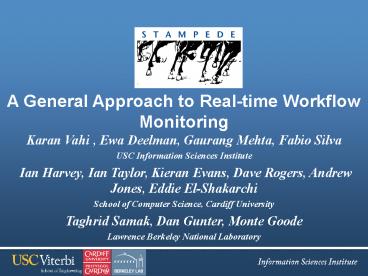A General Approach to Real-time Workflow Monitoring PowerPoint PPT Presentation
Title: A General Approach to Real-time Workflow Monitoring
1
A General Approach to Real-time Workflow
Monitoring
Karan Vahi , Ewa Deelman, Gaurang Mehta, Fabio
Silva USC Information Sciences Institute Ian
Harvey, Ian Taylor, Kieran Evans, Dave Rogers,
Andrew Jones, Eddie El-Shakarchi School of
Computer Science, Cardiff University Taghrid
Samak, Dan Gunter, Monte Goode Lawrence Berkeley
National Laboratory
2
Outline
- Background
- Stampede Data Model
- Triana and Stampede Integration
- Experiments and Analysis Tools
- Conclusions and Future Work
3
Domain Large Scientific Workflows
SCEC-2009 Millions of tasks completed per day
Radius 11 million
4
Goal Real-time Monitoring and Analysis
- Monitor Workflows in real time
- Scientific workflows can involve many
sub-workflows and millions of individual tasks - Need to correlate across workflow and job logs
- Provide realtime updates on the workflow how
many jobs completed, failed etc - Troubleshoot Workflows
- Provide users with tools to debug workflows, and
provide information of why a job failed - Visualize Workflow performance
- Provide a workflow monitoring dashboard that
shows the various workflows run - Provide Analysis tools
- Is a given workflow going to fail?
- Are specific resources causing problems?
- Which application sub-components are failing?
- Is the data staging a problem?
- Do all of this as generally as possible Can we
provide a solution that can apply to all workflow
systems?
5
Outline
- Background
- Stampede Data Model
- Triana and Stampede Integration
- Experiments and Analysis Tools
- Conclusions and Future Work
6
How Does Stampede Provide Interoperability
7
Abstract and Executable Workflows
- Workflows start as a resource-independent
statement of computations, input and output data,
and dependencies - This is called the Abstract Workflow (AW)
- For each workflow run, workflow systems may plan
the workflow, adding helper tasks and clustering
small computations together - This is called the Executable Workflow (EW)
- Note Most of the logs are from the EW but the
user really only knows the AW. The model allows
us to connect jobs in the user specified (AW)
with the jobs in EW executed through Workflow
Systems
8
Entities in Stampede Data Model
- Workflow Container for an entire computation
- Sub-workflow Workflow that is contained in
another workflow - Task Representation of a computation in the AW
- Job Node in the EW
- May represent one or more tasks in the AW. Or can
represent jobs added by Workflow System (e.g., a
stage-in/out), - Job instance Job scheduled or running by
underlying system - Due to retries, there may be multiple job
instances per job - Invocation captures actual invocation of an
executable on - When a job instance is executed on a node, one or
more invocations can be associated. The
invocations capture the runtime execution of
tasks specified in the AW
9
Relationship between Entities in Stampede Data
Model
10
Logs Normalization
- Logging Methodology
- Workflow Systems generate logs in the netlogger
format - Timestamped, named, messages at the start and end
of significant events, with additional
identifiers and metadata in a std. line-oriented
ASCII format (Best Practices or BP) - APIs are provided
- Yang schema to describe the events in netlogger
format - YANG schema documents and validates each log
event - http//acs.lbl.gov/projects/stampede/4.0/stampede-
schema.html
ts2012-03-13T123538.000000Z eventstampede.xwf.
start levelInfo xwf.idea17e8ac-02ac-4909-b5e3-16
e367392556 restart_count0
Example Log Message
11
Outline
- Background
- Stampede Data Model
- Triana and Stampede Integration
- Experiments and Analysis Tools
- Conclusions and Future Work
12
Pegasus Workflow Management System
- A collaboration between USC and the Condor Team
at UW Madison (includes DAGMan) - Takes in a workflow description and can map and
execute it local desktops, condor pool, campus
clusters, grids, commerical and academic clouds - Builds on top of Condor DAGMan.
- Provides reliabilitycan retry computations from
the point of failure - Provides scalabilitycan handle many computations
( 1- 106 tasks) - Automatically captures provenance information
- Can handle large amounts of data ( order of
Terabytes) - Provides workflow monitoring and debugging tools
to allow users to debug large workflows
13
Pegasus Integration with Stampede
14
Triana Workflow System
- Workflow and Data Analysis Environment
- Interactive GUI to enable workflow composition
- Focused on data flows of Java components
- Has a wide range palette of tools that can be
used to design applications - Can distribute workloads to remote Cloud VMs
15
Mapping With Stampede Data Model
16
Triana Integration With Stampede
17
Outline
- Background
- Stampede Data Model
- Triana and Stampede Integration
- Experiments and Analysis Tools
- Conclusions and Future Work
18
Scientific Experiment
- DART Audio Processing Workflow
- DART algorithm is portable and package as a jar
file. - Parameter sweep resulting in 306 DART application
invocations - Executed on a Triana Cloud Deployment in Cardiff
19
Performance Statistics - stampede-statistics
- Workflow Statistics
TASK Statistics Per Sub Workflow
20
Performance Statistics - stampede-statistics
- Job Level Statistics
21
Workflow Analysis using R
22
Troubleshooting and Dashboard
- Stampede-analyzer
- Interactive debugging tool
- Identifies what jobs failed and why they failed
- Drill down functionality for hierarchal workflows
Stampede Dashboard Available Soon
- Lightweight Performance Dashboard
- Online monitoring and status of workflows
- Troubleshoot failed jobs
- Charts and statistics online
23
Outline
- Background
- Stampede Data Model
- Triana and Stampede Integration
- Experiments and Analysis Tools
- Conclusions and Future Work
24
Conclusions and Future Work
- Real-time failure prediction for scientific
workflows is a challenging and important task - Stampede provides a 3 layer model for integration
with different workflow systems - Has been integrated with Pegasus WMS and now with
Triana - Provides users useful real-time monitoring ,
debugging and analysis tools - Apply Workflow and Job Failure prediction models
to Triana Runs - Dashboard for easier visualization of collected
data
25
Thank you!

